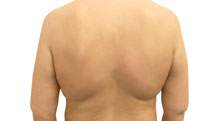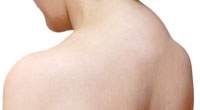
Definition: Lipomatosis is a disease associated with a fat distribution disorder in which multiple (many) lipomas or a lipoma-like accumulation of fatty tissue is found in certain regions.
What forms of lipomatosis have been described?
Lipomatosis is a very rare disease. The definitions can vary in different sources. For example, there are authors who do not include lipoedema in lipomatosis. The following types can be described:
- Madelung’s disease or fatty neck – multiple symmetrical lipomatosis (MSL) – lipomatosis cervicalis (on the neck) is described in more detail below.
- Lipoedema – This is an accumulation of fat on the legs of women, which can also lead to pain. However, the main focus is usually on the cosmetic appearance, which results in severe psychological stress. Lipoedema should initially be treated conservatively with lymphatic drainage and wrapping before surgery is considered. Liposuction for lipoedema is now one of the established procedures.
- Dercum disease = lipomatosis dolorosa (= painful form)
- Familial multiple lipomatosis (FML) is inherited and results in an increase in fatty tissue in the neck, arms, abdomen and thighs. In contrast to Dercum disease, the lipomas are not painful and can often be removed through very small incisions as they are interspersed with plenty of connective tissue.
- Lipomatosis of the heart – fatty heart – lipomatosis cordis
- HIV-associated lipodystrophy is not a classic form of this disease. Lipodystrophy is found in around 40% of people infected with HIV who are undergoing antiretroviral therapy. It is characterized by fat deposits on the neck (buffalo neck) and in the abdominal area, as well as a loss of fatty tissue on the face, legs and arms. Extremely sunken cheeks can often be observed on the face.

Definition of Madelung’s lipomatosis
Madelung’s disease is a very rare and predominantly male (androtropic) symmetrical fat distribution disorder, usually of the upper half of the body, and is therefore also known as multiple symmetrical lipomatosis (MSL).
Causes:
No cause has yet been identified for Madelung’s disease. A certain accumulation can be found in alcoholics. However, this does not mean that people with lipomatosis are alcoholics! The disease occurs more frequently in conjunction with liver dysfunction, lipometabolic disorders and diabetes mellitus.
Localization:

Symmetrical Madelung’s disease is characterized by extreme accumulations of fat in the following regions:
- The neck is referred to as a buffalo neck or bull neck if it is very pronounced.
- Neck – This is where the term Madelung fat neck comes from.
- Shoulder girdle
- Upper arms
- Back
- Chest area
- Rarely does lipomatosis occur in the area of the mons pubis and thighs.
Dercum disease is a painful lipomatosis.
Dercum’s disease = lipomatosis dolorosa (=painful form) = adiposis dolorosa, the cause of which is unknown, was named after the neurologist Francis Dercum (1856-1931).
It is a special form that occurs particularly in women during the menopause. The disease is characterized by painful lipomas on the trunk, legs and arms.
However, the increase in fatty tissue in this lipomatosis can affect all areas of the body and take on grotesque proportions. The disease preferably begins in the 3rd decade of life and is usually accompanied byobesity. An accumulation of diabetes mellitus (diabetes) can be observed.
Treatment:
- If drug-based pain therapy is exhausted, neostigmine, glycine or even immunosuppressants are given, depending on the severity of the dercum lipomatosis, although their list of side effects is long.
- Liposuction or removal of the painful fatty tissue with an incision can improve the pain, but in about half of the cases the fatty tissue grows again.
Can lipomatosis be improved by surgery?
Depending on the findings and the type of fat distribution disorder, if conservative measures have been exhausted, in many cases surgery can correct the external appearance. This can also often reduce the symptoms.
- Liposuction:
Liposuction for lipomatosis is a rewarding operation if it works. The problem lies in the often very firm nature of the fatty tissue, which is interspersed with plenty of connective tissue. Ultrasonic or PAL (vibration-assisted liposuction) liposuction offers a chance here. Furthermore, the fatty tissue is often more heavily supplied with blood (due to the interspersion with connective tissue), which increases the risk of post-operative bleeding. - Surgical variant:
If it is a variant with coarse connective tissue, treatment by liposuction is not helpful. In this case, cutting is the only remaining solution. If large areas are to be corrected, the wound areas will be correspondingly large. In addition to meticulous hemostasis, adequate postoperative compression is also important due to the increased risk of postoperative bleeding. Drains are also generally recommended to make it easier for the fluid (blood and wound water) that is still collecting to find its way out. The Madelung fat neck can be corrected with a neck lift using Z-plasty, which often involves the removal of considerable amounts of fatty tissue.
What should be considered after the operation?
Depending on the extent of the disease and the procedure, strict compression should be applied after the operation using corsetry or appropriate bandages. The drains should be left in place a little longer than is usual with conventional surgery.
It is also important to restrict movement to a certain extent after the operation so that shearing forces do not promote the production of wound fluid or provoke bleeding.

